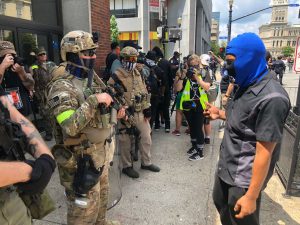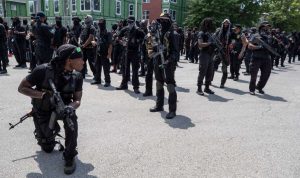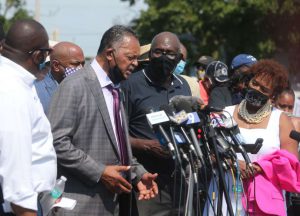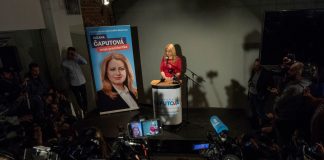AUGUST 29, 2020

An armed man is seen outside the Kenosha County Courthouse in Kenosha on Sunday, Aug. 23, 2020. – Mike De Sisti / Milwaukee Journal Sentinel
As Kyle Rittenhouse secured a legal team Friday after being charged in the fatal shooting of two men at a protest against police brutality, demonstrators and law enforcement grapple with how the deadly gunfire in Kenosha, Wisconsin, has injected a chilling and long-feared dimension into protests.
“We have been very fortunate that shootings have been rare at demonstrations where emotions are already running high, but (Kenosha) is an example of a lot of people’s worst fears,” said Gil Kerlikowske, a former Seattle police chief who also served as Customs and Border Patrol Commissioner during the Obama administration. “We are living in unbelievably unsettling times.”
During a chaotic night of demonstration sparked by the police shooting of Jacob Blake, Rittenhouse told reporters prior to the deadly confrontation that he was armed with a rifle to protect a local parking lot. Wisconsin law allows for gun-owners to carry their firearms in public, though it is unclear whether the Illinois 17-year-old would have been prohibited as a minor.
Illinois authorities said Friday that attorney John Pierce was now representing Rittenhouse, whose first scheduled court hearing was postponed Friday. Pierce could not be immediately reached for comment, but he vowed on Twitter to assemble a “Seal Team” of former federal prosecutors and defense attorneys to assist the teenager.
On the streets, rocks, bottles, Molotov cocktails and fireworks served as protesters’ weapons of choice against bursts of tear gas and rubber bullets. But handguns and rifles, similar to the one Rittenhouse wielded Tuesday night, are increasingly appearing at demonstrations in gun-friendly states that allow their open display — dangling from holsters and shoulder slings. They also loom as potential game-changers for social justice advocates promoting peaceful resistance.
Earlier this week, at least one protester was wounded by gunfire near Bedford, Pennsylvania, in an encounter with local residents, as marchers were passing through on their way to a weekend demonstration in Washington, D.C. In Idaho, an 18-year-old man was sentenced to four days in jail this month for discharging a weapon near a demonstration in Boise.
One of the most unsettling events played out in Michigan this spring when armed protesters crowded inside the state Capitol to oppose a statewide coronavirus lock-down. No one was injured in the demonstration, but the images raised a troubling concern for the security of future demonstrations where firearms are readily available.
Brian Levin, director at California State University San Bernardino’s Center for the Study of Hate and Extremism, called the introduction of weapons during a contentious demonstration “a recipe for disaster.”
“We have to make sure that police departments have policies on how to manage situations when these (armed) people show up,” Levin said. “But unfortunately, the horse seems to have left the barn on that point.”
The ‘inevitable outcome’
The dreaded mix of guns and large crowds has been a persistent and growing concern for law enforcement for years.
Ed Davis, a former Boston police commissioner, said the the violence in Kenosha is the “inevitable outcome” when private citizens – armed with military-grade weapons and driven by visceral reactions – take to the streets to assume the role of law enforcement.

More than 40 Three Percenters demonstrated Saturday at Black Lives Matter protest in Louisville, Kentucky. July 25, 2020. – Chris Kenning/Louisville Courier Journal
“The utilization of these weapons and the type of response that we’ve seen in communities like Kenosha, it’s just unacceptable,” Davis said, adding that the risk to life is “very high when you have untrained individuals utilizing weapons like this.”
Davis said the unrest on display in Kenosha is a symptom of the most profound racial and political division he has seen in the country in more than three decades in law enforcement.

The Not F***ing Around Coalition came to Louisville in support of racial justice while the Three Percenters militia also was in town. Louisville police kept the two groups apart with barricades. The NFAC paused to look for snipers on their march to Jefferson Square for a rally. July 25, 2020. – Pat McDonogh/The Courier Journal
“I don’t see an easy solution to this,” he said. “I think we’re in for a tough time between now and November. Hopefully after November … we can move forward and try to heal, no matter who wins.”
In the run-up to the 2016 party conventions, the country was jolted by a pair of deadly shootings that targeted police officers: an ambush in Baton Rouge where three officers died and an attack at a Dallas protest in which five police officers were killed by a gunman who set out to kill white officers following fatal police shootings of Alton Sterling, Philando Castile and other black men.
The conventions, which featured waves of protesters, were never seriously threatened. Yet the potential risk posed by the introduction of weapons at large, contentious gatherings looms even larger in a country riven by political and racial animus, analysts said.
Last year, as the Secret Secret Service began finalizing its preparations for the 2020 presidential campaign season, cut short by the coronavirus pandemic, a spate of mass shootings added a daunting worst-case scenario to the planning effort.
Agency officials sought the guidance of law enforcement and medical authorities who responded to the 2017 Las Vegas attack on an outdoor music festival in what stands as deadliest mass shooting in American history. The attack, carried out by a single shooter from a hotel room overlooking the music venue, left 59 people dead and more than 400 wounded.
In a new season of civil unrest and in the midst of another contentious presidential election campaign, “nothing is so simple anymore and that includes protests,” said Oren Segal, vice president for the Center on Extremism at the Anti-Defamation League.
“It used to be that demonstrations involved protesters and counter-protesters. You knew what sides people were on,” Segal said. “Now, it’s a challenge for law enforcement because you don’t know who is coming in; you don’t what side they are on. And some of them are carrying guns.”
Segal said the increasingly “complicated” scenario raises a serious question: “Should we even be allowing people with weapons into spaces like this?”
‘I’ve gotta protect myself’
Asked why he felt the need for a gun in the midst of social justice protest, Rittenhouse was ready with an answer: “People are getting injured and our job is to protect this business,” Rittenhouse told a Daily Caller reporter in video interview. “And my job also is to protect people. If someone is hurt, I’m running into harm’s way. That’s why I have my rifle; I’ve gotta protect myself, obviously. But I also have my med kit.”
The encounter would prove more meaningful when it was revealed that Rittenhouse was later charged in connection with the fatal shootings of two men and the wounding of a third victim.
The alleged violent encounters appear to be captured in darkened, yet stunning, video showing a rifle-toting man, a cap turned backward on his head, trotting down the middle of a Kenosha street apparently pursued by others before stumbling to the asphalt.
From a sitting position, the gunman opens fire and at least two people fall wounded, while protesters scream in fear.
After the shooting, video shows the gunman walking quickly toward approaching law enforcement vehicles with his hands up, only to have police pass him by.
The image, juxtaposed with a separate video of police, guns drawn on Blake before he was shot just days earlier have come to represent in stark relief law enforcement’s disproportionate response to Black suspects, analysts said.
“The irony is very difficult to swallow,” Segal said. “The images are significant.”
Rittenhouse was far from the only person carrying a gun during Tuesday’s protests.
Earlier Tuesday, a local militia, known as the Kenosha Guard, posted their intent to join the protests in a Facebook message that appeared to be directed at local police.
“We are mobilizing tonight and have about 3,000 RSVP’s. Our effort has made the national media. I ask that you do NOT have your officers tell us to go home under threat of arrest as you have in the past. We are willing to talk to KPD and open a dis cussion. It is evident, that no matter how many Officers, deputies and other law enforcement officers that are here, you will still be outnumbered.”
Rittenhouse’s own social media posts included references to his strong support of police and his affinity for weapons. An image of Rittenhouse and another man is framed in a blue circle that contains the words: duty, honor, courage and “Blue lives matter.” But it was unclear whether the shooting suspect is connected to the militia group.
Kenosha County Sheriff David Beth acknowledged the intent for an armed intervention, saying that he fielded an inquiry earlier this week.
“I had a person call me and say, ‘Why don’t you deputize citizens who have guns to come out and patrol the city of Kenosha?'” Beth said Wednesday. “And I’m like, ‘Oh Hell, no.’ What happened last night is the perfect reason why I wouldn’t.”
Guy Relford, who has devoted his legal practice to protecting the Second Amendment and recently started a gun rights group in Indiana, acknowledges the right to bear arms to protect their businesses and themselves. (Rittenhouse was not protecting his own business.) But the tense situation in Kenosha raises a lot of uncertainties, especially when guns carried by private citizens are introduced to the mix.
“If you’re looking for a confrontation with a gun, then yeah, that’s not going to end well a lot of times,” Relford said, cautioning that he’s not drawing conclusions about the intentions of Rittenhouse. “And it doesn’t shed a good light on those of us who want to responsibly own and use guns and defend ourselves.”
‘Anxiety, rage, fear’ and determination

Rev. Jesse Jackson, speaks at a press conference near 63rd street and Sheridan in Kenosha.
Elizabeth Brown, an advocate for grieving families in Wisconsin, said the fatal shooting of protesters in Kenosha only makes her more determined to continue raising her own voice.
“I’ve been a black woman in America; every day is violent for me,” she said. “(I want) to go out there and stay out there longer because I just don’t want this to be my daughter’s or my grandchildren’s future. I go out there because I don’t want it to come to my doorstep.”
Brown and other activists drove to Kenosha from Milwaukee in a caravan on Monday, where they joined with local activists. That day, Brown protested alongside Anthony Huber, one of the two protesters fatally shot Tuesday night.
“It tore me apart. I seen it online when it actually happened. It was the same way I felt when I saw Mr. Blake get shot. The same way I felt when I saw Mr. Floyd die,” Brown said. “A tightening in my chest, in my gut. Anxiety. Rage. Fear.”
Courtesy/Source: This article originally appeared on USA TODAY










































































































